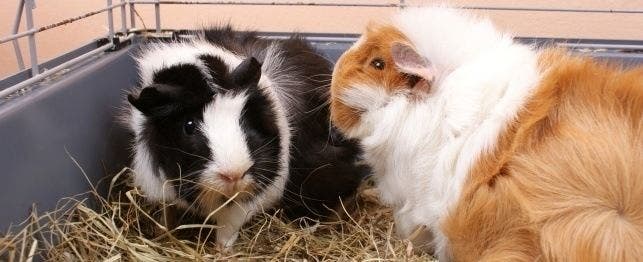
Understanding Your Guinea Pig
Native to the Andes Mountain region of Peru, guinea pigs were first domesticated by the Indians of the region who used them as a food source and sacrificial offering to the Incan gods. Known to scientists as Cavia porcellus (origin of their other common name, “cavy”), guinea pigs made their way to research laboratories in the 18th century and have made significant contributions to the scientific community ever since.
Guinea pigs are relatively long-lived (5 to 7 years) creatures. Their docile, lively and charming personalities make them favorite pets and cavy fanciers have developed an array of colors and hair types. The most common breeds are the English (short and straight hair), Abyssinian (coarse hair with rosettes or whorls) and the Peruvian (long, straight hair parted down the back).
Generally non-aggressive, they rarely bite or scratch. In fact, they do well in groups or “harems” – several females with one male. But several males housed together may fight. Unlike many other pets, cavies do not interact through common grooming behaviors. Instead, they seek direct contact by standing next to the object of their affection.
Guinea pigs are very vocal. They emit a great range of sounds from chutters, whistles and chirps to grunts and squeals. Many guinea pig owners know that reaching for the refrigerator door or box of treats can elicit a delighted squeal from their pet.
Behavior
Guinea pigs are nidifugous, which means, literally, “nest-fleeing.” Babies are born fully furred with open eyes and permanent teeth in place. They are capable of running and eating solid food on their very first day and can be weaned at only three days.
Adults and babies prefer to flee from predators rather than stand and defend themselves. Several of their sensory adaptations favor flight over fight. Guinea pigs hear better than humans, especially at high frequencies, and their sense of smell is highly developed. They have five or six rows of tactile hairs on their muzzles – these are called vibrissae and the guinea pig can use them to measure the width of openings or to find his bearings in the dark. Guinea pigs also have color vision, unlike hamsters and many other rodents, but may have poor depth perception. And if your guinea pig seems a bundle of nervous energy, even during still moments, keep in mind that his resting heart rate is about 275 beats per minute. That’s almost four times faster than the average resting heart rate for man, 70 beats per minute.
A House for Your Guinea Pig
Healthy, happy guinea pigs require some very specific housing considerations. They produce amazing amounts of feces, turn over any unstable container and may defecate and urinate in their feed and water containers. They play with the water bottle nipple and spit a premasticated slurry of food into their sipper bottles. With these antics in mind, simplicity in housing is best.
A plastic, metal or wire cage of at least 18 by 18 inches will provide enough room for one adult but your cavie would probably prefer larger accommodations. Since cavies do not jump or climb very well, the tops of their cages may be left open if the walls are at least 9 to 10 inches tall. Of course, if any ‘predators’ such as inquisitive cats or dogs are in the home, a tight lid should be affixed to the top. The flooring of the cage may be either solid or wire. A wire mesh of 12 by 38 mm will minimize the chance of leg injuries but a solid floor is preferred.
Guinea pigs require a great deal of good housekeeping. Provide an abundant amount of clean, absorbent, relatively dust-free bedding that is easy to replace. Good examples include recycled shredded paper and non-scented wood shavings. Avoid cedar chips and other wood shavings that have oils. Corncob bedding often harbors bacteria and fungi, and is not recommended. Whatever bedding you use, remove and replace it frequently to prevent a buildup of high ammonia levels from your pet’s urine and feces. Ammonia can stress your animal, irritating his nostrils, eyes and lungs. If left unattended, these symptoms can become life threatening. Good ventilation is imperative. If the cage has solid sides, change all of the bedding at least twice a week.
Cavies need places to hide. An upside down cardboard or wooden box with a cut-out door work well. Replace boxes if they get soiled or chewed on. Although they don’t climb well, guinea pigs still like to walk up ramps and climb into low, secure shelves. They also enjoy rooting and burrowing in hay or straw.
Since your pet is more active at night, he requires quiet periods during the day for rest. Locate the cage in an area free of noise, commotion and excitement. Guinea pigs tolerate cooler temperatures better than heat. High heat coupled with high humidity may cause heat stroke. Keep the cage out of direct sunlight in a room with a temperature range of 65 to 75 degrees Fahrenheit.